Detailed Overview of Production Function and Cobb-Douglas Analysis
VerifiedAdded on 2023/06/11
|9
|1507
|159
Essay
AI Summary
This essay provides a comprehensive analysis of the production function, defining it as the technical relationship between factor inputs (land, labor, capital, and organization) and the quantity of output produced. It emphasizes the producer's objective to maximize profit by combining these factors in optimal proportions, adhering to the law of equi-marginal return and substitution. The essay further explores key features of production functions, including substitutability, complementarity, and specificity. A significant portion of the essay is dedicated to the Cobb-Douglas production function, detailing its mathematical form, marginal product, output elasticity, and returns to scale, illustrating how changes in labor and capital affect overall production and demonstrating the conditions under which the function exhibits increasing, decreasing, or constant returns to scale. The document concludes by referencing relevant academic sources, reinforcing the theoretical underpinnings of the analysis.
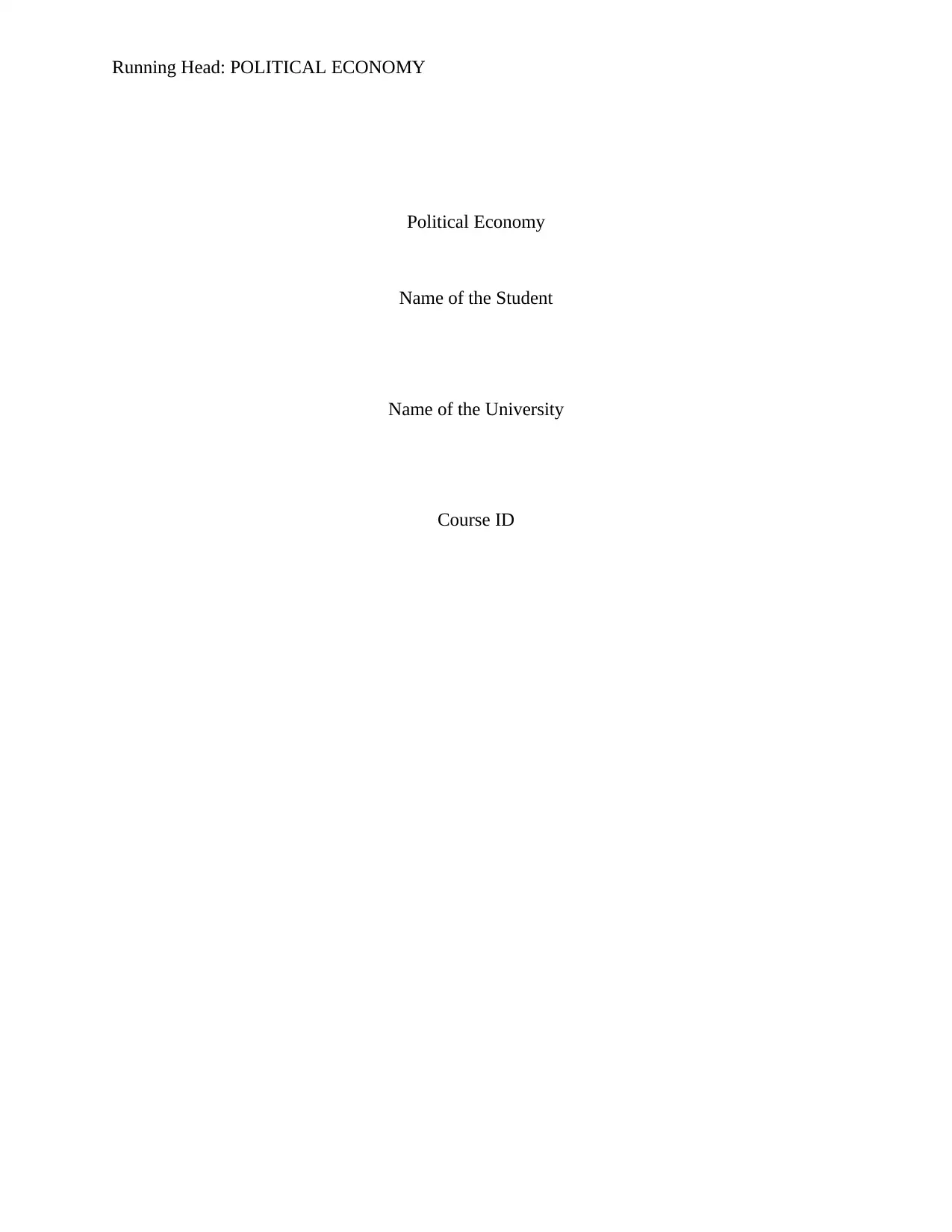
Running Head: POLITICAL ECONOMY
Political Economy
Name of the Student
Name of the University
Course ID
Political Economy
Name of the Student
Name of the University
Course ID
Paraphrase This Document
Need a fresh take? Get an instant paraphrase of this document with our AI Paraphraser

1POLITICAL ECONOMY
Table of Contents
Production Function.........................................................................................................................2
Features of Production Function..................................................................................................3
Cobb-Douglas production function.................................................................................................4
Reference list...................................................................................................................................8
Table of Contents
Production Function.........................................................................................................................2
Features of Production Function..................................................................................................3
Cobb-Douglas production function.................................................................................................4
Reference list...................................................................................................................................8

2POLITICAL ECONOMY
Production Function
Output is produced as a result of interaction between four factors of production namely
land, labor, capital and organization. In the production process, producers combine all the four
factor of production in a certain technical proportion. Objective of producer is to maximize
profit. The producer aims to ensure best possible combination with application of the law of
equi-marginal return and substitution (Fine 2016). According to this law, it is possible for the
producer to produce maximum output only when all the factors of production give equal return.
Production function signifies a technical relation between factor inputs and quantity of
produced output. It depicts a pure technical relation that connects factor of production and
output. The production function thus shows how much output can be expected to produce given a
certain amount of labor and capital (Baumol and Blinder 2015). In other words, production
function represents a physical relation between output and input used by a firm. Production
function is said to represent a physical relation, as money price does not reflect money prices.
Like demand function, production function is also specific to a definite period. It symbolizes
flow of input resulting in flow of output. Production function of a firm is subject to state of
technology. With change in technology production function also undergoes a change (McKenzie
and Lee 2016).
The basic form of production function can be expressed as
Q = f (L, K, N)
Q: Quantity of produced output
L: Labor
Production Function
Output is produced as a result of interaction between four factors of production namely
land, labor, capital and organization. In the production process, producers combine all the four
factor of production in a certain technical proportion. Objective of producer is to maximize
profit. The producer aims to ensure best possible combination with application of the law of
equi-marginal return and substitution (Fine 2016). According to this law, it is possible for the
producer to produce maximum output only when all the factors of production give equal return.
Production function signifies a technical relation between factor inputs and quantity of
produced output. It depicts a pure technical relation that connects factor of production and
output. The production function thus shows how much output can be expected to produce given a
certain amount of labor and capital (Baumol and Blinder 2015). In other words, production
function represents a physical relation between output and input used by a firm. Production
function is said to represent a physical relation, as money price does not reflect money prices.
Like demand function, production function is also specific to a definite period. It symbolizes
flow of input resulting in flow of output. Production function of a firm is subject to state of
technology. With change in technology production function also undergoes a change (McKenzie
and Lee 2016).
The basic form of production function can be expressed as
Q = f (L, K, N)
Q: Quantity of produced output
L: Labor
⊘ This is a preview!⊘
Do you want full access?
Subscribe today to unlock all pages.

Trusted by 1+ million students worldwide

3POLITICAL ECONOMY
K: Capital
N: Land
Quantity of output thus depends on different factor of production such as land, labor and capital.
Production function with only two inputs is expressed as
Q = f (L, K)
Features of Production Function
Specific features of production functions are as follows
Substitutability: Factors of production used in the production process are substitute to one
another Because of substitutability among factors of production; it is possible to change level of
output by varying one or a few inputs keeping all other factors constant (Rader 2014). The law of
variable proportion arises from substitutability among production inputs.
Complementarity: Inputs used in the production process are also complementary to each other.
Output is produced in combination of two or more output. Inputs are put together to produce a
certain amount of output. Nothing can be produced if any of these factors input is zero. Another
application of complementary property of production function is return to scale of production.
Inputs need to be increased simultaneously to attain a higher level of output (Shepherd 2015).
Specificity: The production function specifies factor input to a particular product. Some
examples of specific factors of production are machines and equipment, raw materials and
specialized workers. However, the specific factors can also be used for production of other
commodities too. Hence, specificity is not complete (Fine 2016). This signifies neither of the
factor input can be ignored in the production process.
K: Capital
N: Land
Quantity of output thus depends on different factor of production such as land, labor and capital.
Production function with only two inputs is expressed as
Q = f (L, K)
Features of Production Function
Specific features of production functions are as follows
Substitutability: Factors of production used in the production process are substitute to one
another Because of substitutability among factors of production; it is possible to change level of
output by varying one or a few inputs keeping all other factors constant (Rader 2014). The law of
variable proportion arises from substitutability among production inputs.
Complementarity: Inputs used in the production process are also complementary to each other.
Output is produced in combination of two or more output. Inputs are put together to produce a
certain amount of output. Nothing can be produced if any of these factors input is zero. Another
application of complementary property of production function is return to scale of production.
Inputs need to be increased simultaneously to attain a higher level of output (Shepherd 2015).
Specificity: The production function specifies factor input to a particular product. Some
examples of specific factors of production are machines and equipment, raw materials and
specialized workers. However, the specific factors can also be used for production of other
commodities too. Hence, specificity is not complete (Fine 2016). This signifies neither of the
factor input can be ignored in the production process.
Paraphrase This Document
Need a fresh take? Get an instant paraphrase of this document with our AI Paraphraser
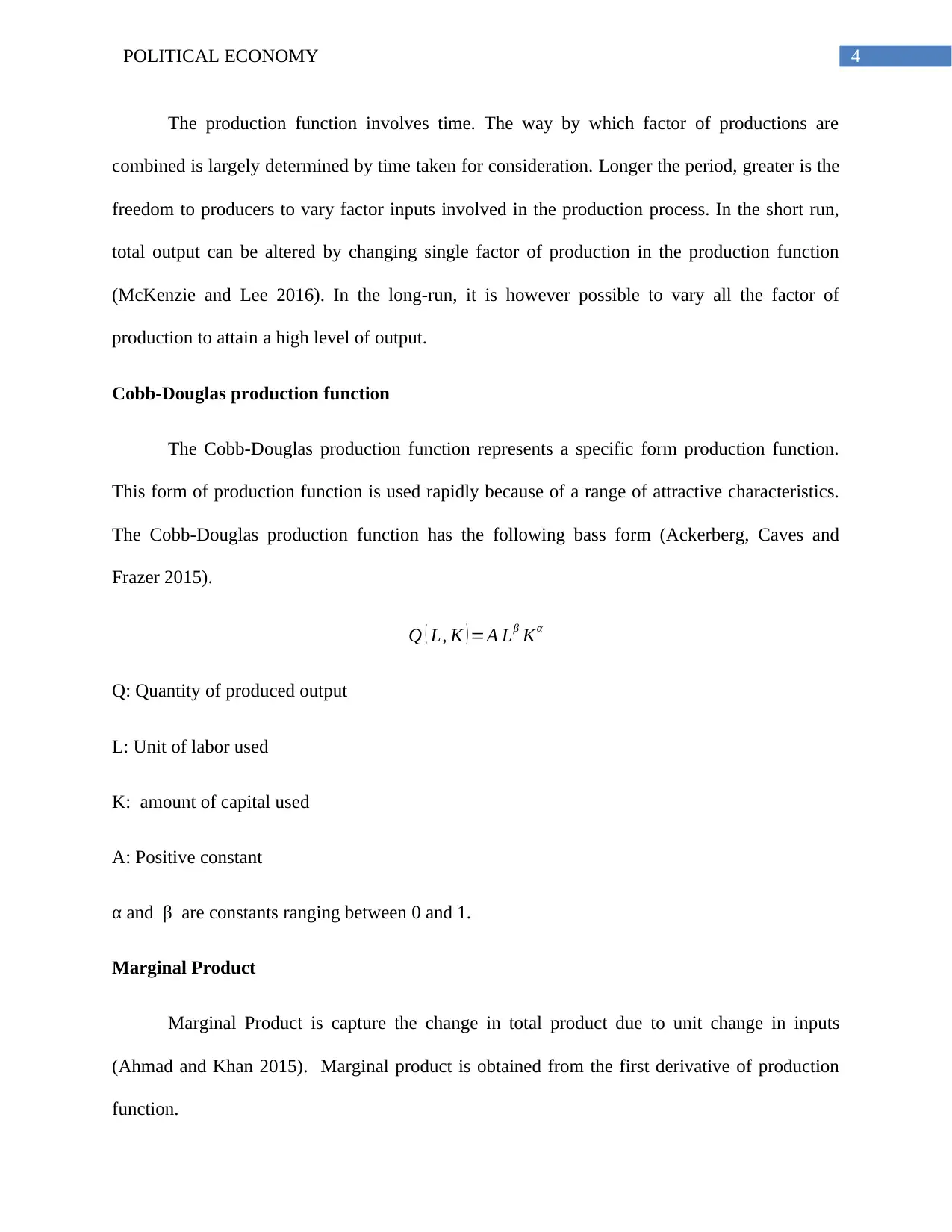
4POLITICAL ECONOMY
The production function involves time. The way by which factor of productions are
combined is largely determined by time taken for consideration. Longer the period, greater is the
freedom to producers to vary factor inputs involved in the production process. In the short run,
total output can be altered by changing single factor of production in the production function
(McKenzie and Lee 2016). In the long-run, it is however possible to vary all the factor of
production to attain a high level of output.
Cobb-Douglas production function
The Cobb-Douglas production function represents a specific form production function.
This form of production function is used rapidly because of a range of attractive characteristics.
The Cobb-Douglas production function has the following bass form (Ackerberg, Caves and
Frazer 2015).
Q ( L, K ) =A Lβ Kα
Q: Quantity of produced output
L: Unit of labor used
K: amount of capital used
A: Positive constant
α and β are constants ranging between 0 and 1.
Marginal Product
Marginal Product is capture the change in total product due to unit change in inputs
(Ahmad and Khan 2015). Marginal product is obtained from the first derivative of production
function.
The production function involves time. The way by which factor of productions are
combined is largely determined by time taken for consideration. Longer the period, greater is the
freedom to producers to vary factor inputs involved in the production process. In the short run,
total output can be altered by changing single factor of production in the production function
(McKenzie and Lee 2016). In the long-run, it is however possible to vary all the factor of
production to attain a high level of output.
Cobb-Douglas production function
The Cobb-Douglas production function represents a specific form production function.
This form of production function is used rapidly because of a range of attractive characteristics.
The Cobb-Douglas production function has the following bass form (Ackerberg, Caves and
Frazer 2015).
Q ( L, K ) =A Lβ Kα
Q: Quantity of produced output
L: Unit of labor used
K: amount of capital used
A: Positive constant
α and β are constants ranging between 0 and 1.
Marginal Product
Marginal Product is capture the change in total product due to unit change in inputs
(Ahmad and Khan 2015). Marginal product is obtained from the first derivative of production
function.
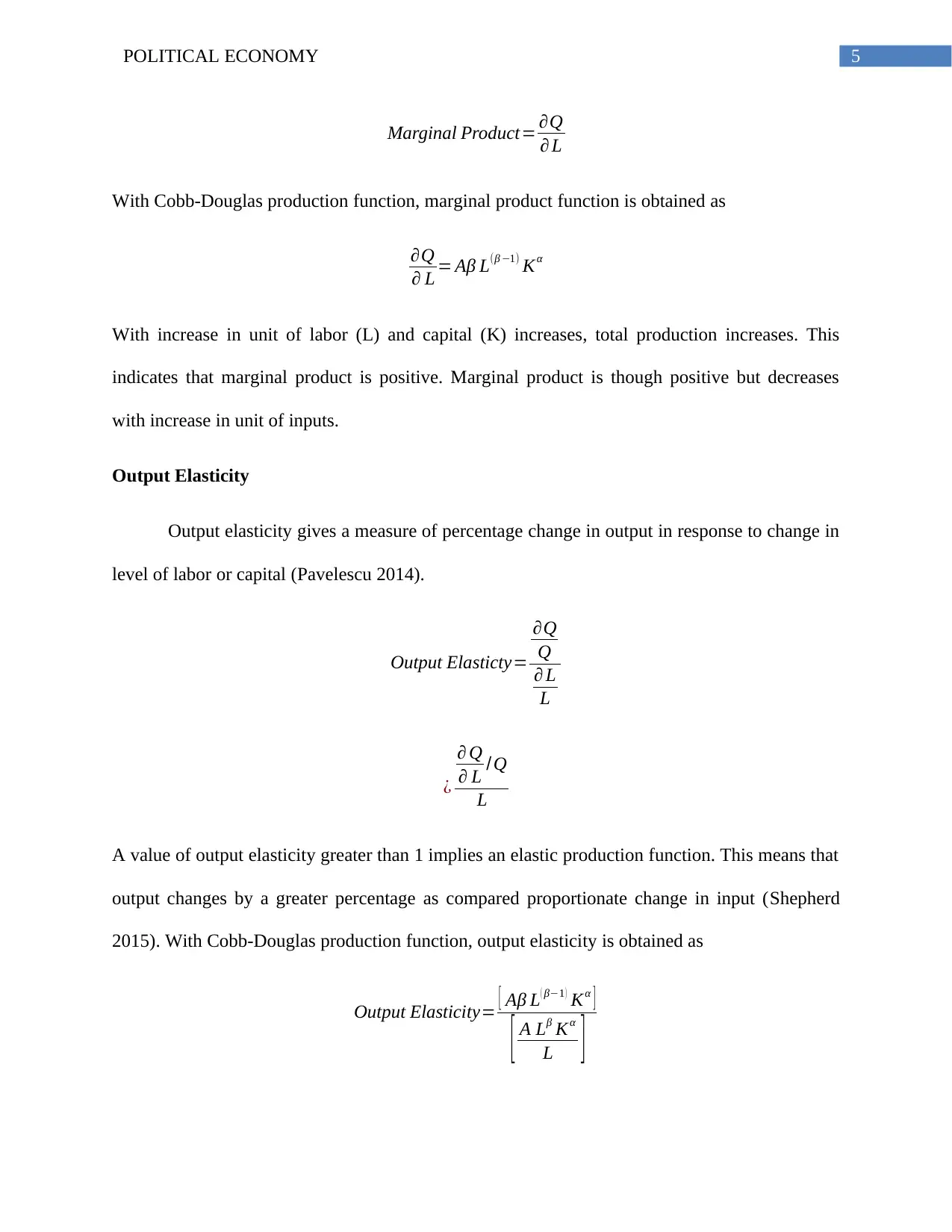
5POLITICAL ECONOMY
Marginal Product= ∂Q
∂ L
With Cobb-Douglas production function, marginal product function is obtained as
∂Q
∂ L = Aβ L(β −1) Kα
With increase in unit of labor (L) and capital (K) increases, total production increases. This
indicates that marginal product is positive. Marginal product is though positive but decreases
with increase in unit of inputs.
Output Elasticity
Output elasticity gives a measure of percentage change in output in response to change in
level of labor or capital (Pavelescu 2014).
Output Elasticty=
∂Q
Q
∂ L
L
¿
∂ Q
∂ L /Q
L
A value of output elasticity greater than 1 implies an elastic production function. This means that
output changes by a greater percentage as compared proportionate change in input (Shepherd
2015). With Cobb-Douglas production function, output elasticity is obtained as
Output Elasticity= [ Aβ L ( β−1 ) Kα ]
[ A Lβ Kα
L ]
Marginal Product= ∂Q
∂ L
With Cobb-Douglas production function, marginal product function is obtained as
∂Q
∂ L = Aβ L(β −1) Kα
With increase in unit of labor (L) and capital (K) increases, total production increases. This
indicates that marginal product is positive. Marginal product is though positive but decreases
with increase in unit of inputs.
Output Elasticity
Output elasticity gives a measure of percentage change in output in response to change in
level of labor or capital (Pavelescu 2014).
Output Elasticty=
∂Q
Q
∂ L
L
¿
∂ Q
∂ L /Q
L
A value of output elasticity greater than 1 implies an elastic production function. This means that
output changes by a greater percentage as compared proportionate change in input (Shepherd
2015). With Cobb-Douglas production function, output elasticity is obtained as
Output Elasticity= [ Aβ L ( β−1 ) Kα ]
[ A Lβ Kα
L ]
⊘ This is a preview!⊘
Do you want full access?
Subscribe today to unlock all pages.

Trusted by 1+ million students worldwide

6POLITICAL ECONOMY
¿ [ Aβ L ( β −1 ) K α ]
[ A Lβ −1 Kα ]
¿ β
The elasticity of production Cobb-Douglas production function with respect to labor us β. As
value of β in the Cobb Douglas production function is less than one, output elasticity is less than
1. A value of β 0.2 implies that with 10 percent change in labor input will change by 2%.
Similarly, output elasticity with respect to capital is constant and is equal to α
Returns to Scale
Return to scale implies change in additional output following a proportionate change in
factors of production. Production function constitutes increasing return to scale if output changes
more than proportionate change in inputs. When output increases less than proportionate change
in input then production function said to have decreasing return to scale (Shepherd 2015). With
constant return to scale, proportionate change in exactly same as proportionate change in input.
For Cobb-Douglas production function, to determine proportionate change in output due to
proportionate change in input inputs are multiplied by a constant factor c. The new level of
output is denoted as Y’.
Y ' = A ¿
¿ A cβ Lβ cα K α
¿ c β cα A Lβ K α
¿ cα + β Y
That is if input changes by a proportion c, output increases bycα+ β.
¿ [ Aβ L ( β −1 ) K α ]
[ A Lβ −1 Kα ]
¿ β
The elasticity of production Cobb-Douglas production function with respect to labor us β. As
value of β in the Cobb Douglas production function is less than one, output elasticity is less than
1. A value of β 0.2 implies that with 10 percent change in labor input will change by 2%.
Similarly, output elasticity with respect to capital is constant and is equal to α
Returns to Scale
Return to scale implies change in additional output following a proportionate change in
factors of production. Production function constitutes increasing return to scale if output changes
more than proportionate change in inputs. When output increases less than proportionate change
in input then production function said to have decreasing return to scale (Shepherd 2015). With
constant return to scale, proportionate change in exactly same as proportionate change in input.
For Cobb-Douglas production function, to determine proportionate change in output due to
proportionate change in input inputs are multiplied by a constant factor c. The new level of
output is denoted as Y’.
Y ' = A ¿
¿ A cβ Lβ cα K α
¿ c β cα A Lβ K α
¿ cα + β Y
That is if input changes by a proportion c, output increases bycα+ β.
Paraphrase This Document
Need a fresh take? Get an instant paraphrase of this document with our AI Paraphraser
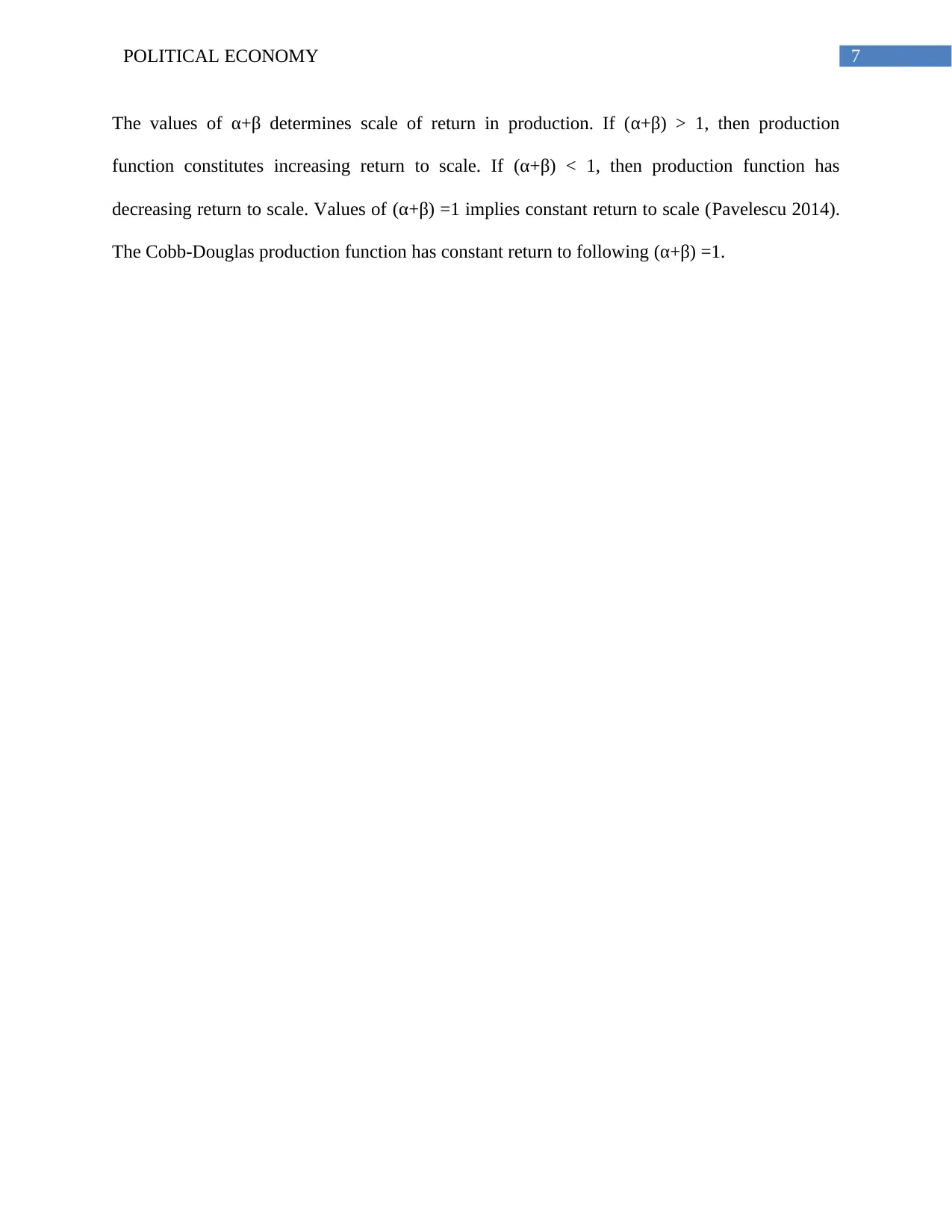
7POLITICAL ECONOMY
The values of α+β determines scale of return in production. If (α+β) > 1, then production
function constitutes increasing return to scale. If (α+β) < 1, then production function has
decreasing return to scale. Values of (α+β) =1 implies constant return to scale (Pavelescu 2014).
The Cobb-Douglas production function has constant return to following (α+β) =1.
The values of α+β determines scale of return in production. If (α+β) > 1, then production
function constitutes increasing return to scale. If (α+β) < 1, then production function has
decreasing return to scale. Values of (α+β) =1 implies constant return to scale (Pavelescu 2014).
The Cobb-Douglas production function has constant return to following (α+β) =1.
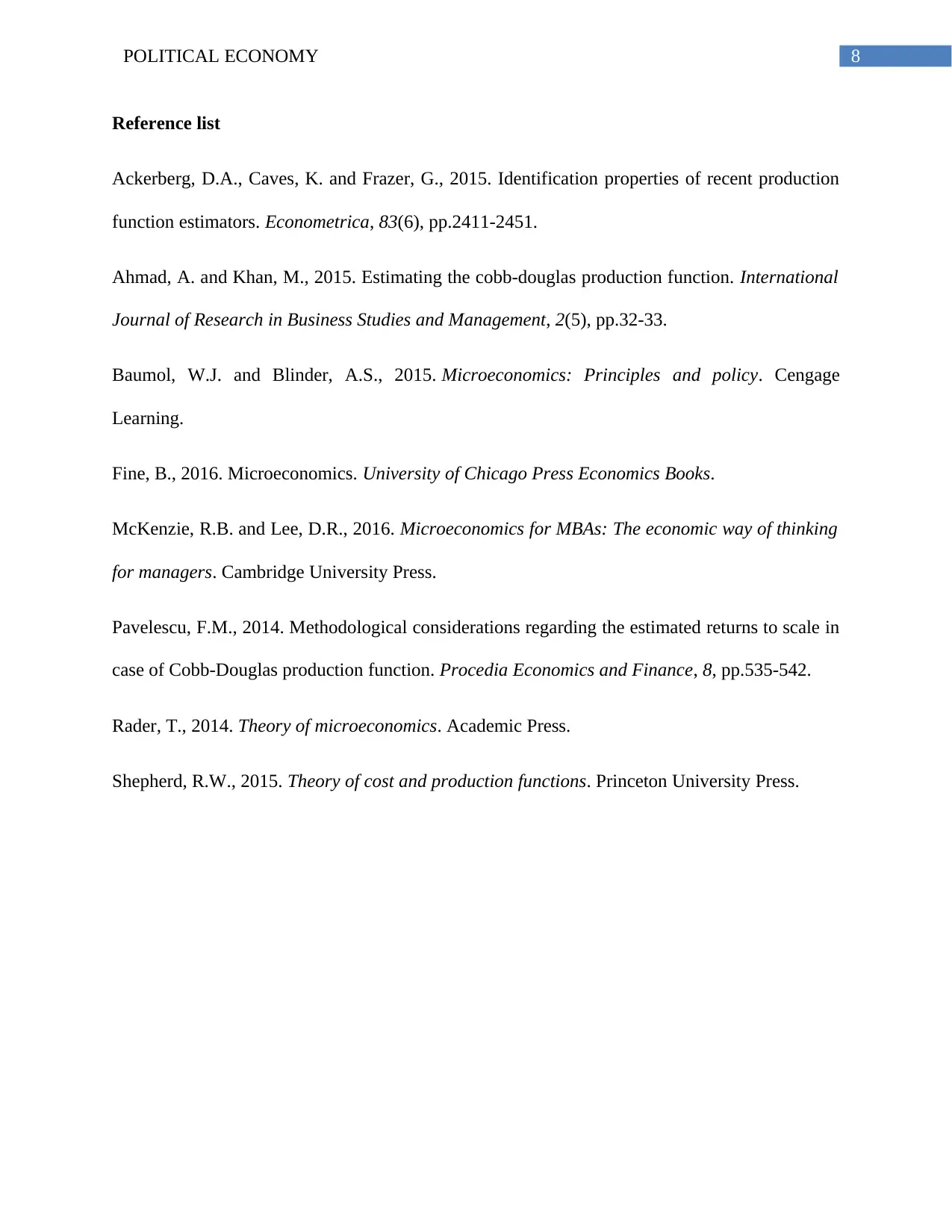
8POLITICAL ECONOMY
Reference list
Ackerberg, D.A., Caves, K. and Frazer, G., 2015. Identification properties of recent production
function estimators. Econometrica, 83(6), pp.2411-2451.
Ahmad, A. and Khan, M., 2015. Estimating the cobb-douglas production function. International
Journal of Research in Business Studies and Management, 2(5), pp.32-33.
Baumol, W.J. and Blinder, A.S., 2015. Microeconomics: Principles and policy. Cengage
Learning.
Fine, B., 2016. Microeconomics. University of Chicago Press Economics Books.
McKenzie, R.B. and Lee, D.R., 2016. Microeconomics for MBAs: The economic way of thinking
for managers. Cambridge University Press.
Pavelescu, F.M., 2014. Methodological considerations regarding the estimated returns to scale in
case of Cobb-Douglas production function. Procedia Economics and Finance, 8, pp.535-542.
Rader, T., 2014. Theory of microeconomics. Academic Press.
Shepherd, R.W., 2015. Theory of cost and production functions. Princeton University Press.
Reference list
Ackerberg, D.A., Caves, K. and Frazer, G., 2015. Identification properties of recent production
function estimators. Econometrica, 83(6), pp.2411-2451.
Ahmad, A. and Khan, M., 2015. Estimating the cobb-douglas production function. International
Journal of Research in Business Studies and Management, 2(5), pp.32-33.
Baumol, W.J. and Blinder, A.S., 2015. Microeconomics: Principles and policy. Cengage
Learning.
Fine, B., 2016. Microeconomics. University of Chicago Press Economics Books.
McKenzie, R.B. and Lee, D.R., 2016. Microeconomics for MBAs: The economic way of thinking
for managers. Cambridge University Press.
Pavelescu, F.M., 2014. Methodological considerations regarding the estimated returns to scale in
case of Cobb-Douglas production function. Procedia Economics and Finance, 8, pp.535-542.
Rader, T., 2014. Theory of microeconomics. Academic Press.
Shepherd, R.W., 2015. Theory of cost and production functions. Princeton University Press.
⊘ This is a preview!⊘
Do you want full access?
Subscribe today to unlock all pages.

Trusted by 1+ million students worldwide
1 out of 9
Related Documents
Your All-in-One AI-Powered Toolkit for Academic Success.
+13062052269
info@desklib.com
Available 24*7 on WhatsApp / Email
![[object Object]](/_next/static/media/star-bottom.7253800d.svg)
Unlock your academic potential
Copyright © 2020–2025 A2Z Services. All Rights Reserved. Developed and managed by ZUCOL.





